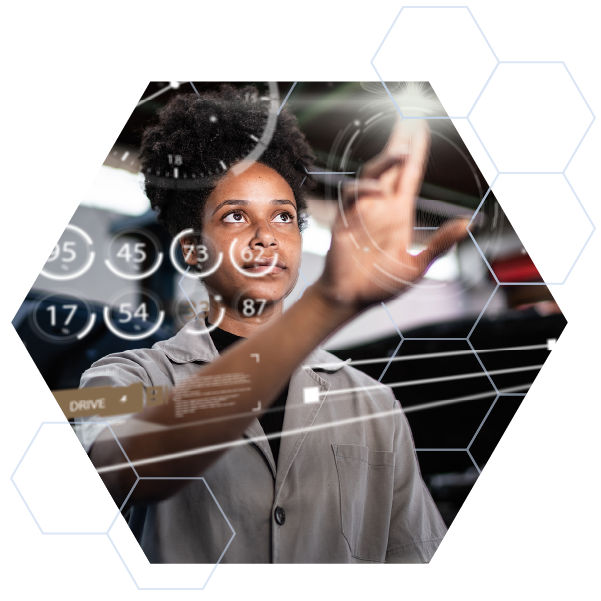Generative AI Overview
Companies of all sizes are intrigued by the benefits that artificial intelligence (AI) offers. Many are already using AI and predictive analytics to make better decisions and improve their operations. Generative AI is an emerging subset of AI that gives additional value. It can quickly create audio, text, and video content—even write code. Businesses are beginning to use this technology to create more personal experiences, enhance data sets, and solve data-quality problems.
Generative AI has uses in the supply chain that could be of interest to GS1 US members. It could improve resilience by simulating disruptions to help plan for risks. It could automate content and logistics through generation of product data. It could help the customer experience by giving personalized product recommendations. Or it could be used to improve sustainability by optimizing travel routes and recommending methods to reduce environmental impact.
However, these models can “hallucinate.” Their output is not always based on fact. And due to the nature of training data, there are questions about privacy, plagiarism, and ownership. Still, the generative AI hype cycle continues, and adoption is increasing. Alongside our members, GS1 US will continue to investigate this space by piloting new use cases and work to discover the future potential of this technology.

What is Generative AI?
Generative AI is a type of artificial intelligence (AI) that can make new content. It does this by learning from examples of real-world data and extrapolating from there. Based on the type of training data, generative AI can generate a variety of content such as audio, text, code, images, videos, and even digital simulations. It analyzes trends, patterns, relationships, and structures within the training data in an attempt to mimic human intelligence. A large language model (LLM) is a version of generative AI focused specifically on generating text. ChatGPT, created by OpenAI, is an example of an LLM. Other types of generative AI exist that can cover a variety of use cases, primarily through their ability to create new content from historical data. Generative AI models can also improve themselves by learning from user feedback and adapting to new data input into their system. Over time, the model will increase in accuracy and capability to enable a wide array of new opportunities for AI.
How does Generative AI work?
Prediction and reinforcement drive generative AI. LLMs, for example, work by predicting the word that is most likely to come next in a sequence of words. This is achieved by training the model on a large amount of real-world data. ChatGPT was trained on a combination of books, Wikipedia entries, online articles and other pieces of writing from the internet that amounted to about 300 billion words. Generative AI for other types of media, like images or code, works in a similar way to LLMs. In addition to prediction, reinforcement learning with human feedback (RLHF) is used to grade the results. A human auditor will review the generative AI’s response, grade it with either positive or negative feedback, and the algorithm will learn from that feedback and adjust its next response. Safety guardrails can also be embedded into the algorithm to prevent it from generating dangerous or problematic responses.
Generative AI Use Cases
Generative AI has a variety of uses. While mainly used for creating new content, it can do more than predict the next word in a sequence. The following are some of today’s known uses. As the technology evolves, its functionality is likely to grow.
1 | Content Creation
Content creation is the core of generative AI. These cases use algorithms to create a variety of content in a fast-paced, scalable way. For example, marketing can generate images for campaigns or programmers can autonomously create lines of code.
2 | Chatbots
Generative AI can mimic human speech through natural language processing (NLP). This means that it can provide customer service via text chatbots. Its ability to learn from human feedback allows it to understand preferences and create highly personalized experiences based on customer responses.
3 | Data Augmentation
Generative AI can help improve the quality or completeness of datasets. Based on historical data, generative AI can fill in gaps within a database. It can also assess overall data trends to identify anomalies within the system. A more robust dataset, generated by AI, could then be used to train and improve the performance of deep learning algorithms.
4 | Digital Simulation
Generative AI can create content at scale and use existing data to build simulations of real-world environments. The speed at which it can generate content means that generative AI can build digital twins of complex ecosystems, which can then be used to simulate different scenarios. Humans can study them to understand potential outcomes, cause and effect relationships, and more.
5 | Design & Discovery
Generative AI can use historical product data to create new designs for various industries. For medical research, generative AI systems can accurately predict 3D models of protein structures at high speeds. This significantly improves biological research and development.
Generative AI in the Supply Chain
Generative AI can help supply chains in several ways. AI predictions, simulations, and recommendations can support automation and improve efficiency. But it is important to think of this technology as a collaborator. It is meant to enhance the valuable work done by people in the supply chain. In that light, generative AI shows potential in the following areas:
Communication
Generative AI can help translate for trading partners across the globe. Chatbots can read and summarize documents, as well as write messages to help businesses work together.
GS1 Standards can help make these communications easier. Unique identity, global recognized data models, and interoperable business messages ensure clarity from a single source of truth in exchanges about products, places, and events across the supply chain. Best practices and standardization for data and supply chain information can also guide the AI translating, summarizing, or creating content.
Data Quality
Generative AI can use pattern recognition to flag anomalies within datasets. It can generate data to fill in gaps to improve completeness or enrich product data with additional information. It can also check for and correct errors before sharing the data with trading partners.
GS1 Standards can act as guardrails to the data created by generative AI. Standards like the GS1 image specification can serve as a foundation and guide the AI with best practices to help generate more accurate, useful results.
Inventory Management
Generative AI can create models that show different supply and demand scenarios to help manage inventory. By applying insights from past data to these models, it can recommend orders and stock levels.
For these models, data quality is key. GS1 Standards help make product data consistent across supply chains. Good quality data will lead to better results from the AI.
Resilience
Generative AI can create digital twins of supply chains. These AI simulations can let users test how their supply chain might respond to different disruptions or changes. AI trained on historical weather patterns, environmental data, and supply chain disruptions can simulate future events. This can aid in risk assessment and contingency planning.
GS1 Standards can help companies collaborate on creating resilient supply chains. Standards serve as a foundation to build a rich set of transactional and event data for a supply chain. This data can provide insights into visibility, inventory, performance, and lifecycle management. That way, companies know when to implement contingency plans.
Fulfillment
Generative AI designs can be used for logistics. AI can generate optimized routes for fulfillment. It can learn from feedback to dynamically adjust. Generative AI can also support fill rates with recommendations and substitutions based on historic data, preferences, and product or customer attributes.
GS1 Standards can be used to implement the AI-generated route. Product, location, and entity standards are all essential to building logistics routes in an open and interoperable way.
Sustainability
Generative AI can be used to enhance sustainability. A generative AI can help design a product with new materials or redesign packaging to use less. Or it could lay out the supply chain for a current product to minimize its environmental impact, from sourcing raw materials and suppliers through manufacturing and distribution.
After a sustainable supply chain is designed, GS1 Standards can help make it real. Standards help enable data sharing and trust among each partner within the supply chain. From there, they can collaborate to implement the design.
Personalization & Customer Experience
Through user feedback, generative AI can learn, iterate, and provide highly personalized experiences. For example, it can provide product recommendations that are very specifically tailored to a customer’s preferences. Based on how the customer responds to the initial recommendations, it can update and refine the process for future interactions.
GS1 US has standardized product information and attributes that generative AI can learn from to further improve its ability to create personalized, custom experiences for users. The more data the AI has about a product, the better its ability to adjust to user feedback.

Generative AI’s Limitations and Risks
Despite the vast capabilities of generative AI, there are a number of limitations and risks that need to be considered. One of the most prominent risks of generative AI solutions is the potential to hallucinate. An AI hallucination occurs when the system provides a result or information that is untrue, which means it uses its predictive generation to fabricate information. For example, a regional Australian mayor has spoken about suing OpenAI if the company does not correct false claims that ChatGPT made about his past. Human collaborators are still necessary to fact-check the results of generative AI.
Generative AI is also susceptible to drift, a phenomenon where its performance changes over time. Stanford conducted a study that analyzed this drift from May to June across four categories: math problems, sensitive questions, software code, and visual reasoning. The results show a drift where the AI performed worse in some categories. These fluctuations in the models’ results over time further highlight the need for human monitoring to ensure consistency.
In addition, the fact that publicly available generative AI models require large amounts of training data scraped from the internet has created its own set of problems. There are data privacy concerns around who owns the data when it is entered into an AI system and when the results are output.
These risks can be mitigated by training LLMs on private data sets. Companies can safely investigate generative AI when they have control over its training data, selecting what data sets feed it and using enterprise instances that protect data access. In addition, human validation can reduce the risk of inaccurate or false generative AI results. Oversight, in the form of human verification, is still required for these AI systems.

Input quality training data
Humans equipped with Standards should ensure the quality (accuracy and completeness) of input data.

Validate results
Users equipped with Standards should check the output for accuracy.

Provide feedback to the model
Users should provide feedback on the accuracy of the results and the quality of output back into the system for training.
Interested in generative AI in the supply chain?
Whether you're looking for more information, want to exchange ideas with peer thought leaders, or are interested in piloting how GS1 Standards can help you apply generative AI, we want to hear from you.
About Innovation & Partnerships at GS1 US
The Innovation & Partnerships (I&P) team at GS1 US helps drive business transformations by collaborating with first movers and disruptors.
We work with industry thought leaders and stakeholders, including government, regulators, associations, startups, and academia, to find solutions and establish ways of doing business that everyone can leverage to meet the growing demands of today’s consumers. We forge a dialogue to identify and develop standards that support industry-wide transformation.
Innovate With Us
Collaboration fuels innovation, and we want to work with you. There is an opportunity at every level. Whether you are an industry leader, a tech disruptor, a start-up, or somewhere in between, together, we can identify innovations and develop new industry standards.
There are a variety of ways to innovate with us. They range from networking to media opportunities and speaking engagements. From workgroup discussions to our Solution Partner Program. From authoring thought leadership content to proof of concepts and pilots. In a pilot or proof of concept, we work together to form and test a hypothesis, and then share the findings for the benefit of industry.
Help change the way we do business, today and tomorrow.

Recommended Articles
Here are additional resources that might interest you.
© 2023 GS1 US All Rights Reserved.
This content may not be copied, reproduced, printed, distributed, or published, electronically or physically, in whole or in part, in any and all media, without the express consent of the owner. The use of all GS1 Standards is voluntary and not mandatory. GS1 US is making this information available to be used for educational purposes only. The views, information, or opinions expressed regarding Generative AI do not necessarily represent those of GS1 US, its employees, or member companies. This publication has been provided as a convenience and does not constitute or imply an endorsement, recommendation, or favoring of Generative AI or any of the identified companies, products, or services by GS1 US. GS1 US does not warrant nor guarantee any of the products or services identified herein or the reliability or accuracy of content generated using Generative AI, nor does it assume any legal liability or responsibility regarding the same. Prior to the creation and distribution of content generated using Generative AI, it is recommended that you seek legal counsel to assess the compliance of said content with all applicable laws and regulations regarding intellectual property, data privacy, and/or other rights held by third parties.




